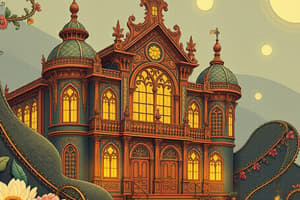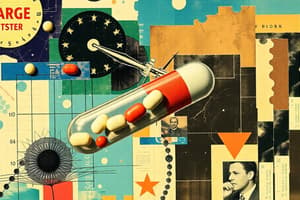Podcast
Questions and Answers
Which of the following BEST describes innovation?
Which of the following BEST describes innovation?
- The exclusive focus on improving existing products to maintain market share.
- The process of creating value from an idea. (correct)
- The strict adherence to established operational procedures to ensure consistency.
- The process of generating numerous ideas without regard for their practical application.
A company notices an increasing demand for sustainable packaging driven by consumer awareness. Which source of innovation does this BEST represent?
A company notices an increasing demand for sustainable packaging driven by consumer awareness. Which source of innovation does this BEST represent?
- Process needs
- Perceptual changes (correct)
- Demographic changes
- Unexpected occurrences
Which of the following innovations represents a disruptive innovation in the transportation industry?
Which of the following innovations represents a disruptive innovation in the transportation industry?
- Introducing hybrid engines that combine electric and gasoline power.
- Improving the fuel efficiency of gasoline engines.
- Adding advanced safety features to traditional cars.
- Developing electric scooters for urban commuting. (correct)
A beverage company decides to launch a new flavor of its existing soda. Which dimension of innovation does this initiative primarily represent?
A beverage company decides to launch a new flavor of its existing soda. Which dimension of innovation does this initiative primarily represent?
According to the model of the innovation and entrepreneurial process, which stage primarily focuses on refining knowledge to make it feasible?
According to the model of the innovation and entrepreneurial process, which stage primarily focuses on refining knowledge to make it feasible?
Which of the following is considered a crucial element of the 'incubation' phase within the creative process?
Which of the following is considered a crucial element of the 'incubation' phase within the creative process?
A software engineer enjoys coding and finds great satisfaction in solving complex problems, leading them to consistently develop innovative solutions. Which component of creativity is MOST evident in this scenario?
A software engineer enjoys coding and finds great satisfaction in solving complex problems, leading them to consistently develop innovative solutions. Which component of creativity is MOST evident in this scenario?
A startup is evaluating whether they can produce their new tech gadget using current technology. Which critical issue are they primarily addressing?
A startup is evaluating whether they can produce their new tech gadget using current technology. Which critical issue are they primarily addressing?
As a creative technique, which approach involves identifying the attributes of an object or idea and systematically exploring ways to modify or improve each attribute?
As a creative technique, which approach involves identifying the attributes of an object or idea and systematically exploring ways to modify or improve each attribute?
How are creativity, innovation, and entrepreneurship linked?
How are creativity, innovation, and entrepreneurship linked?
Which of the following BEST describes the societal market orientation stage?
Which of the following BEST describes the societal market orientation stage?
A technology company uses data analytics to understand customer preferences and then designs new products to meet those specific needs. Which marketing orientation does this exemplify?
A technology company uses data analytics to understand customer preferences and then designs new products to meet those specific needs. Which marketing orientation does this exemplify?
In the context of marketing, who are considered 'clients'?
In the context of marketing, who are considered 'clients'?
Which of the following BEST describes the micro-environment in marketing?
Which of the following BEST describes the micro-environment in marketing?
A small bakery faces direct competition from several other bakeries in the same neighborhood offering similar products. Which type of competition does this scenario represent?
A small bakery faces direct competition from several other bakeries in the same neighborhood offering similar products. Which type of competition does this scenario represent?
Which of the following BEST describes the influence of political forces on marketing decisions?
Which of the following BEST describes the influence of political forces on marketing decisions?
A significant increase in the average disposable income of a target market would be considered which type of macro-environmental force?
A significant increase in the average disposable income of a target market would be considered which type of macro-environmental force?
Growing concern about climate change and its effects on the environment represents which type of macro-environmental force?
Growing concern about climate change and its effects on the environment represents which type of macro-environmental force?
In a SWOT analysis, which of the following would be classified as an 'opportunity'?
In a SWOT analysis, which of the following would be classified as an 'opportunity'?
Which of the following would be considered a marketing metric?
Which of the following would be considered a marketing metric?
Which aspect of the marketing plan defines the specific group of consumers that the company aims to attract and serve?
Which aspect of the marketing plan defines the specific group of consumers that the company aims to attract and serve?
Which of the following exemplifies 'improving operations' as an aspect of innovation?
Which of the following exemplifies 'improving operations' as an aspect of innovation?
A company notices a significant drop in sales of a previously popular product after a competitor launches a similar product with more advanced features. Which source of innovation is MOST relevant in this scenario?
A company notices a significant drop in sales of a previously popular product after a competitor launches a similar product with more advanced features. Which source of innovation is MOST relevant in this scenario?
A car manufacturer continually releases new models with small improvements to fuel efficiency, safety features, and interior design. Which type of innovation does this represent?
A car manufacturer continually releases new models with small improvements to fuel efficiency, safety features, and interior design. Which type of innovation does this represent?
Which of the following dimensions of innovation involves changing the way a product is perceived and used by consumers?
Which of the following dimensions of innovation involves changing the way a product is perceived and used by consumers?
In the creative process, which stage involves testing and refining potential solutions to improve a product or service?
In the creative process, which stage involves testing and refining potential solutions to improve a product or service?
Which creative technique involves viewing a problem from an opposite or inverted perspective?
Which creative technique involves viewing a problem from an opposite or inverted perspective?
Which of the following orientations is most concerned with minimizing negative impacts on society?
Which of the following orientations is most concerned with minimizing negative impacts on society?
In marketing, 'Value' is best described as:
In marketing, 'Value' is best described as:
Which of the following is the best example of a monopsony?
Which of the following is the best example of a monopsony?
Flashcards
Define Innovation
Define Innovation
Creating value from ideas.
Opportunities
Opportunities
Finding or making new chances, like Airbnb.
Serving Existing Markets
Serving Existing Markets
Better ways to serve current markets, like mobile ordering.
Growing New Markets
Growing New Markets
Signup and view all the flashcards
Rethinking Services
Rethinking Services
Signup and view all the flashcards
Meeting Social Needs
Meeting Social Needs
Signup and view all the flashcards
Improving Operations
Improving Operations
Signup and view all the flashcards
Unexpected Occurrences
Unexpected Occurrences
Signup and view all the flashcards
Incongruities
Incongruities
Signup and view all the flashcards
Process Needs
Process Needs
Signup and view all the flashcards
Industry/Market Changes
Industry/Market Changes
Signup and view all the flashcards
Demographic Changes
Demographic Changes
Signup and view all the flashcards
Perceptual Changes
Perceptual Changes
Signup and view all the flashcards
New Knowledge
New Knowledge
Signup and view all the flashcards
Incremental Innovation
Incremental Innovation
Signup and view all the flashcards
Disruptive Innovation
Disruptive Innovation
Signup and view all the flashcards
Product Innovation
Product Innovation
Signup and view all the flashcards
Process Innovation
Process Innovation
Signup and view all the flashcards
Position Innovation
Position Innovation
Signup and view all the flashcards
Paradigm Innovation
Paradigm Innovation
Signup and view all the flashcards
Creativity
Creativity
Signup and view all the flashcards
Association
Association
Signup and view all the flashcards
Incremental and Radical Ideas
Incremental and Radical Ideas
Signup and view all the flashcards
Divergent/Convergent Thinking
Divergent/Convergent Thinking
Signup and view all the flashcards
Pattern Recognition
Pattern Recognition
Signup and view all the flashcards
Recognition
Recognition
Signup and view all the flashcards
Incubation
Incubation
Signup and view all the flashcards
Insight
Insight
Signup and view all the flashcards
Refinement
Refinement
Signup and view all the flashcards
Creative Thinking
Creative Thinking
Signup and view all the flashcards
Knowledge
Knowledge
Signup and view all the flashcards
Motivation
Motivation
Signup and view all the flashcards
Intrinsic Motivation
Intrinsic Motivation
Signup and view all the flashcards
Extrinsic Motivation
Extrinsic Motivation
Signup and view all the flashcards
Creativity Stage Knowledge
Creativity Stage Knowledge
Signup and view all the flashcards
Innovation Stage Knowledge
Innovation Stage Knowledge
Signup and view all the flashcards
Entrepreneurial Stage Knowledge
Entrepreneurial Stage Knowledge
Signup and view all the flashcards
Product Feasibility
Product Feasibility
Signup and view all the flashcards
Market Feasibility
Market Feasibility
Signup and view all the flashcards
Economic Feasibility
Economic Feasibility
Signup and view all the flashcards
Problem Reversal
Problem Reversal
Signup and view all the flashcards
Forced Analogy
Forced Analogy
Signup and view all the flashcards
Attribute Listing
Attribute Listing
Signup and view all the flashcards
Mind Map
Mind Map
Signup and view all the flashcards
Brainstorming
Brainstorming
Signup and view all the flashcards
Marketing
Marketing
Signup and view all the flashcards
Exchange (Marketing)
Exchange (Marketing)
Signup and view all the flashcards
Production Oriented
Production Oriented
Signup and view all the flashcards
Sales Oriented
Sales Oriented
Signup and view all the flashcards
Market Oriented
Market Oriented
Signup and view all the flashcards
Societal Market Orientation
Societal Market Orientation
Signup and view all the flashcards
Value
Value
Signup and view all the flashcards
Market
Market
Signup and view all the flashcards
Customers
Customers
Signup and view all the flashcards
Consumers
Consumers
Signup and view all the flashcards
Clients
Clients
Signup and view all the flashcards
Partners
Partners
Signup and view all the flashcards
Society
Society
Signup and view all the flashcards
Marketing
Marketing
Signup and view all the flashcards
Internal Marketing
Internal Marketing
Signup and view all the flashcards
External Environment.
External Environment.
Signup and view all the flashcards
Micro environment
Micro environment
Signup and view all the flashcards
Customer/Clients
Customer/Clients
Signup and view all the flashcards
Logistic firms
Logistic firms
Signup and view all the flashcards
Competitors.
Competitors.
Signup and view all the flashcards
Pure Competition
Pure Competition
Signup and view all the flashcards
Monopolistic Competition
Monopolistic Competition
Signup and view all the flashcards
Oligopoly
Oligopoly
Signup and view all the flashcards
Monopoly
Monopoly
Signup and view all the flashcards
Monopsony
Monopsony
Signup and view all the flashcards
PESTEL
PESTEL
Signup and view all the flashcards
Political Force
Political Force
Signup and view all the flashcards
Strength
Strength
Signup and view all the flashcards
Weakness
Weakness
Signup and view all the flashcards
Opportunities
Opportunities
Signup and view all the flashcards
Threat
Threat
Signup and view all the flashcards
Study Notes
- Innovation is creating value from ideas.
Six Aspects of Innovation:
- Identifying or creating opportunities (e.g., Airbnb).
- New ways of serving existing markets (e.g., mobile ordering apps).
- Growing new markets (e.g., Tesla electric cars).
- Rethinking services (e.g., decreasing computer size).
- Meeting social needs (e.g., Instagram and Twitter).
- Improving operations (e.g., robotics in manufacturing, mining, and medicine).
Seven Sources of Innovation:
- Unexpected occurrences: Events altering consumer needs.
- Incongruities: Gaps between product offerings and expectations.
- Process needs: Innovations increasing efficiency and reducing repetitive tasks.
- Industry and market changes: Improvements in technologies, economies, and regulations.
- Demographic changes: Shifts in population size, age, location, education, or income.
- Perceptual changes: Changes in customer preferences and acceptance over time.
- New knowledge: Innovations driven by scientific discoveries.
Incremental vs. Disruptive Innovation:
- Incremental innovation improves existing products (e.g., petrol cars to hybrid cars).
- Disruptive innovation changes the market entirely (e.g., electric cars).
Four Dimensions of Innovation:
- Product: Changes in physical goods.
- Process: Changes in how products are delivered.
- Position: Changes in the product's context.
- Paradigm: Changes in the product's underlying model.
Creativity
- Creativity is the production of new and useful ideas.
Nature of Creativity:
- Association between problems and ideas.
- Uses both incremental and radical ideas.
- Employs divergent (exploring) and convergent (focusing) thinking.
- Utilizes both left and right brain functions.
- Pattern recognition.
- Can be an individual or group activity.
The Creative Process:
- Recognition: Identifying the problem.
- Incubation: Allowing ideas to develop.
- Insight: Achieving a deep understanding; seeking expert advice.
- Refinement: Testing and improving solutions.
Three Components of Creativity:
- Creative thinking: Approaches to problems and solutions.
- Knowledge: Acquired from education, experience, and interaction.
- Motivation: Determination to act.
- Intrinsic motivation: Enjoyment of work.
- Extrinsic motivation: Financial rewards.
Knowledge Development During Entrepreneurship:
- Creativity Stage: Knowledge in raw form.
- Innovation Stage: Knowledge refined for feasibility.
- Entrepreneurial Stage: Knowledge implemented in a product/service.
- All three stages involve knowledge development.
Screening Opportunities:
- Product Feasibility: Can it be made with current tech?
- Market Feasibility: Does it have desired features/value?
- Economic Feasibility: Can it be profitable?
Creative Techniques:
- Problem Reversal: Viewing the problem from an opposite angle.
- Forced Analogy: Linking two unrelated things for new insights.
- Attribute Listing: Identifying and listing product attributes.
- Mind Map: Visually mapping information.
- Brainstorming: Generating ideas in a group.
Marketing
- Marketing involves creating, communicating, delivering, and exchanging offerings that have value for customers, clients, partners, and society.
The Evolution of Marketing:
- Exchange: Trading goods for needs.
- Production Oriented: Buying what is available.
- Sales Oriented: Increasing profits through advertising.
- Market Oriented: Making products that suit consumer wants.
- Societal Market Orientation: Minimizing negative societal impact.
Applications of Marketing:
- Used by businesses, non-profits, and governments.
Marketing Perspective:
- Left Brain (Science): Understanding customer needs using information.
- Right Brain (Art): Developing unique, creative offers.
The Marketing Process:
- Involves understanding the market to improve offerings.
Value Definition:
- Value = Quality / Price
- Value = Benefits Expected / Benefits Received
Market Definition:
- A market is a group of customers with needs and wants.
Market Groups:
- Customers: Purchase goods/services.
- Consumers: Use the goods/services.
- Clients: Customers of non-profits.
- Partners: Involved in the exchange process.
- Society: Members of a community.
The Marketing Environment:
- Includes all internal and external factors.
Environment Types:
- Internal: Controllable elements inside the organization.
- External: Uncontrollable elements outside the organization.
The Micro Environment:
- Not directly controllable.
- Includes customers, clients, partners, and competitors.
Understanding the Micro Environment:
- Need to understand current and future target market needs
- Customers & clients
- understand the current and future needs and wants of their target market
- Partners: Logistic firms, financiers, advertising agencies, retailers, wholesalers, suppliers
- Competitors:
- Customers & clients
Types of Competitors:
- Pure Competition: Many businesses sell the same product (e.g., sugar).
- Monopolistic Competition: Many businesses sell similar but differentiated products (e.g., laptops).
- Oligopoly: Few large companies dominate (e.g., airlines).
- Monopoly: One supplier (e.g., government-run roads).
- Monopsony: One buyer controls the market (e.g., government buying submarines).
The Macro Environment:
- PESTEL framework:
- Political, economic, sociocultural, technological, environmental, and legal forces.
- Political forces
- describe the influence marketing decisions
- lobbying, favourable regulation, etc
- economic forces
- factors that affect how people can spend and how they choose to spend it
- include income, prices, the level of savings, the level of debt and the availability
- Sociocultural force
- affects people attitude, belief, behaviours, preference, customs and lifestyle
- Technological forces
- better way of doing things
- suppliers work
- Environmental forces
- natural disaster etc
- logical awareness and social changes influence how firms will operate
- Legal forces
- Laws— legislation enacted by elected officials
- Regulations— rule made under authority delegated by legislation.
- Political forces
- Political, economic, sociocultural, technological, environmental, and legal forces.
SWOT Analysis:
- Evaluate internal and external factors.
- Marketing metrics
Components:
- Strengths: Attributes that help achieve objectives (internal).
- Weaknesses: Attributes that hinder achieving objectives (internal).
- Opportunities: Factors that help achieve objectives (external).
- Threats: Factors harmful to achieving objectives (external).
The Marketing Plan:
- Executive summary
- Introduction
- Situation analysis (SWOT)
- Objectives (SMART)
- Target market
- Marketing mix strategy
- Budget
- Implementation
- Evaluation (marketing metrics)
- Conclusion/future recommendations
Studying That Suits You
Use AI to generate personalized quizzes and flashcards to suit your learning preferences.




